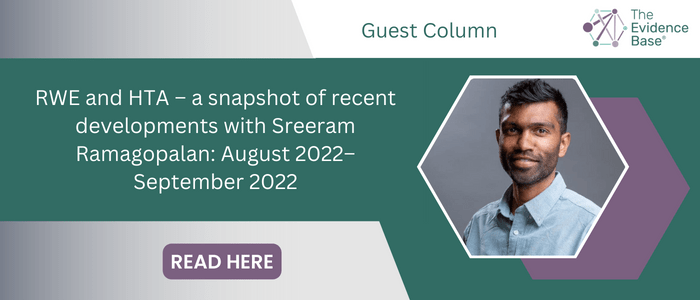RWE and HTA – a snapshot of recent developments with Sreeram Ramagopalan: August–September 2022

Read highlights from the latest instalment of Sreeram Ramagopalan’s (F. Hoffman La Roche, Basel, Switzerland) industry news round-up, which discusses some of the latest developments regarding real-world evidence (RWE) in the context of health technology assessment (HTA) and is published bi-monthly in our partner journal, the Journal of Comparative Effectiveness Research.
Read the full update for August–September 2022 in the Journal of Comparative Effectiveness Research here >>>
What happened over these months that you were expecting?
A publication from a survey of EUnetHTA member HTA organizations which demonstrates how these agencies have a widespread concern accepting RWD from countries outside of their region. This is to be expected given feedback provided by these agencies during submissions when largely US data has been provided. However, this is nevertheless disappointing as in many cases this is the only data available.
What happened that surprised you over these months?
Somewhat contrary to the above is the feedback from Germany’s Institute for Quality and Efficiency in Health Care (IQWiG) for benefit assessments for sotorasib and amivantanab. For both of these submissions, IQWiG suggested that data from Flatiron Health could have been used (citing the use of this data in other submissions for these molecules), despite this data source only including data on patients from the US. It is unclear whether these recent requests for the use of US data by IQWiG is indeed truly reflective of a more widespread shift in attitude toward the use of international RWD by this agency, or if these were special cases due to the lack of appropriate local data. Hopefully it is the former, as this would represent an important step towards increasing access to therapies for patients living in countries where there is a paucity of readily accessible high-quality RWD.
If we only read about one story related to real-world data and healthcare innovation, what should it be?
Transportability relates to whether inferences from one population can be extended to a separate (external) population from which the study sample was not derived (for example, applying findings from a US population to that of Germany). An excellent recent review of transportability methods suggests that differences in key effect modifiers across countries does not necessarily need to mean results are not transportable. The review highlights that if analysts have access to data on the target population, and data on effect modifiers are available in both the target sample and study sample, methods similar to those used to adjust for confounding, such as regression-based, weighting-based and doubly-robust methods, can be applied to ensure balance on effect modifiers. Therefore, by employing these methods, data from one country could potentially be used to robustly address questions in another.
What do you think the larger implications of some of the developments discussed in your latest column piece may be for the field?
Concerns regarding external validity due to the use of international RWD are valid, but HTA agencies must recognize that there are often trade-offs between locality and other aspects of data quality. Demonstration studies highlighting the applicability of transportability methods and which countries results can be transported between will be invaluable. Hopefully then the best available data can be used for HTA decision making for patient access to medicines, rather than blocking anything that is not homegrown.
Disclaimers:
Sreeram Ramagopalan is an employee of F. Hoffmann-La Roche.
The opinions expressed in this feature are those of the interviewee/author and do not necessarily reflect the views of The Evidence Base® or Becaris Publishing Ltd.






